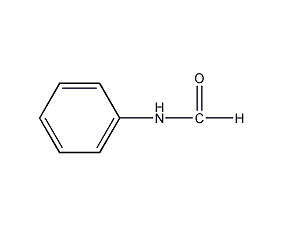
Structural formula
| Business number | 02P1 |
|---|---|
| Molecular formula | C7H7NO |
| Molecular weight | 121.14 |
| label |
N-phenylcarboxamide, N-formanilide, formanilide, n-Formanilide, N-Benzamide, Carbanilaldehyde, Formamidobenzene, Formamilide, N-Formanilide, n-formyl-anilin |
Numbering system
CAS number:103-70-8
MDL number:MFCD00003276
EINECS number:203-136-0
RTECS number:BY1780000
BRN number:906934
PubChem number:24871333
Physical property data
1. Properties: Monoclinic prism crystal
2. Density (g/mL, 20℃): 1.112
3. Relative vapor density (g/mL, air = 1): Undetermined
4. Melting point (ºC): 50
5. Boiling point (ºC, normal pressure): 271
6. Boiling point (ºC) , 16kpa): 216
7. Refractive index: not determined
8. Flash point (ºC): not determined
9. Specific rotation (º ): Undetermined
10. Autoignition point or ignition temperature (ºC): Undetermined
11. Vapor pressure (mmHg,ºC): Undetermined
12. Saturated vapor pressure (kPa, ºC): Undetermined
13. Heat of combustion (KJ/mol): Undetermined
14. Critical temperature (ºC): Undetermined
15. Critical pressure (KPa): Undetermined
16. Log value of oil-water (octanol/water) partition coefficient: Undetermined
17. Explosion upper limit (%, V/V): Undetermined
18. Explosion lower limit (%, V/V): Undetermined
19. Solubility: Easily soluble in ethanol, Soluble in ether.
Toxicological data
Acute toxicity: Dog oral LDLo: 400mg/kg; Dog intravenous LDLo: 400mg/kg; Amphibians-frog oral LDLo: 800μg/kg;
Ecological data
This substance is slightly hazardous to water.
Molecular structure data
1. Molar refractive index: 36.04
2. Molar volume (cm3/mol): 106.2
3. Isotonic specific volume (90.2K ): 275.0
4. Surface tension (dyne/cm): 44.9
5. Dielectric constant:
6. ���Polar distance (10-24cm3):
7. Polarizability: 14.29
Compute chemical data
1. Reference value for hydrophobic parameter calculation (XlogP): None
2. Number of hydrogen bond donors: 1
3. Number of hydrogen bond acceptors: 1
4. Number of rotatable chemical bonds: 1
5. Number of tautomers: 2
6. Topological molecule polar surface area 29.1
7. Number of heavy atoms: 9
8. Surface charge: 0
9. Complexity: 86.9
10. Number of isotope atoms: 0
11. Determine the number of atomic stereocenters: 0
12. Uncertain number of atomic stereocenters: 0
13. Determine the number of chemical bond stereocenters: 0
14. Number of uncertain chemical bond stereocenters: 0
15. Number of covalent bond units: 1
Properties and stability
Avoid contact with strong oxidizing agents.
Storage method
Store in a cool, ventilated warehouse. Keep away from fire and heat sources. The packaging must be sealed and must not come into contact with air. should be kept away from oxidizer, do not store together. Equipped with the appropriate variety and quantity of fire equipment. The storage area should be equipped with emergency release equipment and suitable containment materials.
Synthesis method
Obtained from the reaction of aniline and formic acid. Add 2.8kg aniline, 2kg toluene, and 3L formic acid into a flask equipped with a fractionating column, heat and dehydrate for half an hour, and after the reaction, toluene is distilled and recovered to 110°C. Cool, filter out the crystals, and distill under reduced pressure to obtain formanilide.
Purpose
Used in organic synthesis.

 微信扫一扫打赏
微信扫一扫打赏

